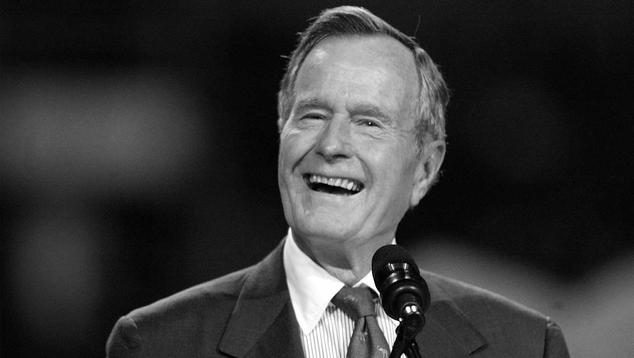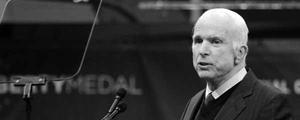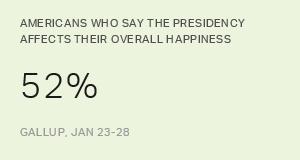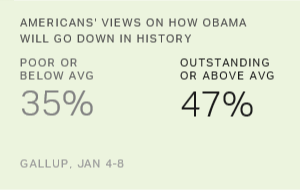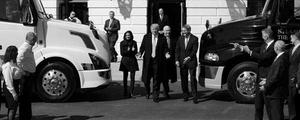WASHINGTON, D.C. -- President George H.W. Bush held office at a time of global transition, spanning the end of the Cold War, the breakup of the Soviet Union and the U.S. victory in the first Gulf War. Bush's job approval rating was well above average for the first three years of his presidency, including one of the highest approval ratings in Gallup's history. Despite this, his job rating sank dramatically as economic woes, particularly rising unemployment, took hold in the U.S., foreshadowing his defeat in the 1992 election.

Bush's initial approval rating, taken just a few days after his inauguration in January 1989, was fairly low as far as inaugural ratings go, at 51%, mainly because 43% of Americans did not yet have an opinion of him. His subsequent early-term readings were near 60% and surged to 70% after the Tiananmen Square incident in China in June 1989.
Widely hailed for his foreign policy experience, Bush enjoyed ratings mainly in the 70% range as the Cold War was coming to an end, symbolically marked by the opening of the Berlin Wall in November 1989. U.S. success internationally continued after Bush ordered the invasion of Panama and deposed the country's leader, Manuel Noriega. After that successful December 1989 military action, his job approval rating rose to 80% in January 1990, which at the time ranked among the highest in Gallup's history.
Economic Stumbles in 1990 Preceded Iraq War Rally
From that point, Bush's ratings trended downward, dropping to 60% in July, reflecting in part his forsaking his campaign pledge not to institute new taxes ("Read my lips: No New Taxes"). The U.S. economy was also showing signs of weakening, eventually falling into the recession which was later defined as starting in July 1990.
Bush's job approval rating shot up to 74% in early August, after he sent U.S. troops to Saudi Arabia in response to Iraqi leader Saddam Hussein's invasion of Kuwait. His approval rating stayed near that level for about a month, but declined to 54% in November 1990 amid increasing unease about a possible war and a rise in U.S. gas prices.
After Hussein failed to comply with a U.N. mandate to leave Kuwait by Jan. 15, 1991, the U.S.-led coalition began the Persian Gulf War on Jan. 16. Bush's approval rating surged from 64% the week prior to the start of military action to 82% right after it, staying high throughout the war. After victory in the war, in March of that year, Bush received an 89% approval rating, the highest presidential job approval rating ever recorded to that date, eclipsed only by his son George W. Bush's 90% approval rating after the 9/11 terrorist attacks.
Bush's approval rating remained above 80% until mid-April 1991, but gradually declined over the course of the year as Americans' attention shifted from the Persian Gulf to the struggling U.S. economy. Though the recession officially ended in March 1991, the perception among Americans that the economy was in poor shape persisted well into the next year. By October, with Bush's nomination of Clarence Thomas to the Supreme Court, his approval rating dropped below 60%.
1992 Brings Bush Multiple Challenges
Election year 1992 began with Bush's approval rating at 46%, the first time it had dropped below the majority level. It slipped further to the low 40s amid the 1992 presidential primaries in which Bush beat back a challenge for the Republican nomination from conservative commentator Patrick Buchanan while the Democrats coalesced around Arkansas Gov. Bill Clinton. Billionaire businessman H. Ross Perot also entered the race in early 1992, as a conservative-leaning independent who threatened to siphon votes from Bush in the fall.
The U.S. faced additional challenges over the next several months, most notably the Los Angeles race riots in April and May. However, Bush's job approval held near 40% until June, when it dipped further to 37%, after campaign clashes with Perot.
Bush's job approval rating sunk to the lowest point of his presidency, 29%, in July 1992, after Clinton and his party's leaders focused their message on the poor state of the economy at the well-received Democratic National Convention.
In slightly more than a year's time, Bush had gone from having the highest job approval rating to one of the lowest Gallup has measured, only slightly better than the readings in the mid- to low 20s Harry Truman and Richard Nixon received at the end of their presidencies.
Bush had a bump in job approval ratings to 38% after the Republican Party's convention in August, but faltered again in October. His final pre-election approval rating was 34% in late October, before losing the election to Clinton. Bush received 37.5% of the popular vote to Clinton's 43% and Perot's 19%.
Ending on a High Note
After Bush's loss and shift to presidential lame-duck status, his job approval rating rose significantly, first to 43% in late November, and then to 49% in December and 56% in his final reading in January 1993.
In December, Bush deployed U.S. troops to aid in famine relief and political stabilization efforts in Somalia. In mid-January 1993, the U.S. and allies launched air strikes in Iraq after it violated no-fly-zone provisions in the 1991 cease-fire agreement. Increases in approval are not uncommon for presidents preparing to leave office, but Bush enjoyed the biggest increase between the Election Day that chose his successor and his last day in office.
Throughout his presidency, Bush consistently received higher levels of approval for his handling of foreign affairs than for the economy. Gallup took readings on Americans' approval of Bush's handling of the two issues 19 times during his presidency. He averaged 35% approval for his handling of the economy and 63% for foreign affairs. Public skepticism of his economic stewardship greatly contributed to Bush's re-election defeat.
Bush's Average Approval Rating Compares Favorably to Other Presidents
Overall, George H.W. Bush averaged a 61% job approval rate throughout his single term as president, with solid ratings in his first three years in office more than offsetting the lows he received in his last year. Only two presidents in Gallup polling had higher average job approval ratings over the course of their presidencies -- John F. Kennedy averaged 70% during his abbreviated single term and Dwight Eisenhower averaged 65% across two full terms. Bush's term average remains the highest of any president who served in the past 50 years.
| Dates in office | Average approval rating | ||||||||||||||||||||||||||||||||||||||||||||||||||||||||||||||||||||||||||||||||||||||||||||||||||
|---|---|---|---|---|---|---|---|---|---|---|---|---|---|---|---|---|---|---|---|---|---|---|---|---|---|---|---|---|---|---|---|---|---|---|---|---|---|---|---|---|---|---|---|---|---|---|---|---|---|---|---|---|---|---|---|---|---|---|---|---|---|---|---|---|---|---|---|---|---|---|---|---|---|---|---|---|---|---|---|---|---|---|---|---|---|---|---|---|---|---|---|---|---|---|---|---|---|---|---|
| % | |||||||||||||||||||||||||||||||||||||||||||||||||||||||||||||||||||||||||||||||||||||||||||||||||||
| John Kennedy | January 1961-November 1963 | 70 | |||||||||||||||||||||||||||||||||||||||||||||||||||||||||||||||||||||||||||||||||||||||||||||||||
| Dwight Eisenhower | January 1953-January 1961 | 65 | |||||||||||||||||||||||||||||||||||||||||||||||||||||||||||||||||||||||||||||||||||||||||||||||||
| George H.W. Bush | January 1989-January 1993 | 61 | |||||||||||||||||||||||||||||||||||||||||||||||||||||||||||||||||||||||||||||||||||||||||||||||||
| Lyndon Johnson | November 1963-January 1969 | 55 | |||||||||||||||||||||||||||||||||||||||||||||||||||||||||||||||||||||||||||||||||||||||||||||||||
| Bill Clinton | January 1993-January 2001 | 55 | |||||||||||||||||||||||||||||||||||||||||||||||||||||||||||||||||||||||||||||||||||||||||||||||||
| Ronald Reagan | January 1981-January 1989 | 53 | |||||||||||||||||||||||||||||||||||||||||||||||||||||||||||||||||||||||||||||||||||||||||||||||||
| George W. Bush | January 2001-January 2009 | 49 | |||||||||||||||||||||||||||||||||||||||||||||||||||||||||||||||||||||||||||||||||||||||||||||||||
| Richard Nixon | January 1969-August 1974 | 49 | |||||||||||||||||||||||||||||||||||||||||||||||||||||||||||||||||||||||||||||||||||||||||||||||||
| Barack Obama | January 2009-January 2017 | 48 | |||||||||||||||||||||||||||||||||||||||||||||||||||||||||||||||||||||||||||||||||||||||||||||||||
| Gerald Ford | August 1974-January 1977 | 47 | |||||||||||||||||||||||||||||||||||||||||||||||||||||||||||||||||||||||||||||||||||||||||||||||||
| Jimmy Carter | January 1977-January 1981 | 46 | |||||||||||||||||||||||||||||||||||||||||||||||||||||||||||||||||||||||||||||||||||||||||||||||||
| Harry Truman | April 1945-January 1953 | 45 | |||||||||||||||||||||||||||||||||||||||||||||||||||||||||||||||||||||||||||||||||||||||||||||||||
| Gallup | |||||||||||||||||||||||||||||||||||||||||||||||||||||||||||||||||||||||||||||||||||||||||||||||||||
Retrospective Views of Bush's Presidency
In the years since Bush's presidency, Americans' retrospective view of his performance has been consistently positive. In February of this year, 64% of Americans said they approved of the job Bush had done as president. This trailed the ratings for Kennedy (86%) and Ronald Reagan (72%) but was similar to those for two recent past presidents, including 62% for Clinton and 63% for Barack Obama.
While Bush's retrospective ratings have been positive, roughly a quarter of Americans (27%) in January 2017 said he will be remembered as an "outstanding" or "above average" president, with 20% rating him "below average" or "poor." Americans were most likely to describe his presidency as "average," with 51% doing so.
During his lifetime, Bush ranked in the top 10 of Gallup's most admired men 20 times beginning in 1984, including finishing first from 1989 through 1992 when he was president. Eight other men have made the top 10 more times than Bush, including five other presidents: Nixon, Eisenhower, Clinton, Jimmy Carter and Reagan. Bush was most recently in the top 10 in 2012.
Bottom Line
Bush's presidency, viewed through the lens of public opinion, can be evaluated as a success, with an overall job approval rating better than all but two presidents since World War II. Bush was also a president whose performance evaluations changed dramatically over the course of just four years. Historic international events and interventions led to high ratings his first three years in office, but a drifting economy and inadequate actions on the domestic front ultimately eroded his support during his re-election year.
Bush remained active in the 25 years after he left office, joining with his former opponent, Clinton, to support humanitarian relief efforts, notably those for the 2005 Asian tsunami. He remained in the spotlight after becoming only the second president in U.S. history to have a son elected president. Americans' final retrospective approval rating of Bush aligns more with his relatively strong overall average rating as president and the improved final readings of his presidency than the lower ratings leading up to his failed re-election bid.
Explore President George H.W. Bush's approval ratings and compare them with those of past presidents in the Gallup Presidential Job Approval Center.
